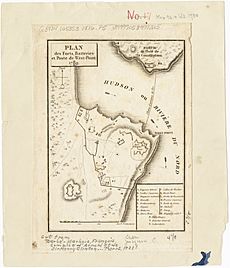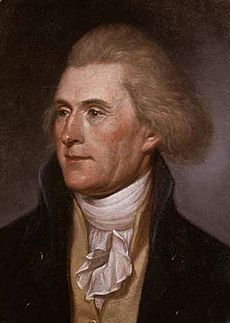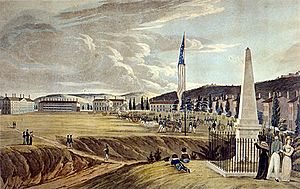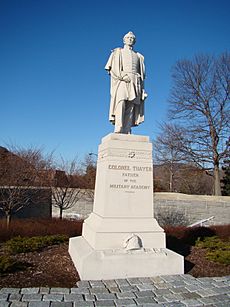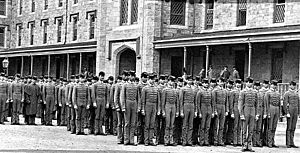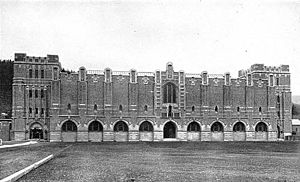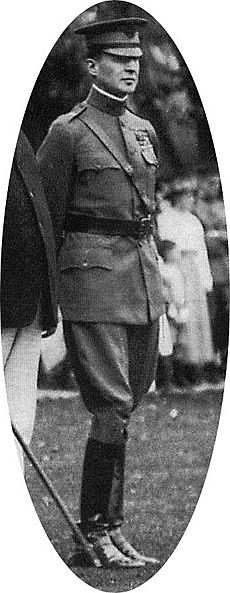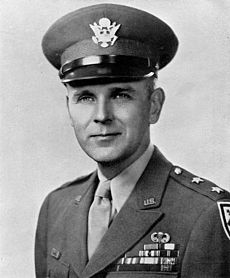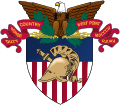History of the United States Military Academy facts for kids
The history of the United States Military Academy is a story that began during the American Revolutionary War. In 1778, important forts were built at West Point, a strategic spot on the Hudson River. After the war, in 1802, President Thomas Jefferson officially created the United States Military Academy (USMA) there. Later, in 1817, a leader named Sylvanus Thayer made big changes that shaped the academy into what it is today.
Contents
- West Point's Beginnings: A Fort in the Revolution
- How the Academy Was Founded
- Early Years of West Point
- Sylvanus Thayer: The "Father of the Military Academy"
- West Point and the Mexican-American War
- From the Mexican War to the Civil War
- After the Civil War: New Faces and Changes
- The Early 1900s and World War I
- Between the World Wars: Modernizing West Point
- World War II and Beyond
- Women at West Point: A New Era
- Academy Coat of Arms
West Point's Beginnings: A Fort in the Revolution
West Point became a military post in 1778, making it the longest continuously occupied military site in the United States. George Washington, the leader of the Continental Army, thought West Point was the most important military spot in America. He even set up his headquarters there in 1779.
After the war, the U.S. government bought the land at West Point in 1790. This was important for keeping the area secure.
Between 1778 and 1780, a Polish engineer and hero named Tadeusz Kościuszko helped build the defenses at West Point. His small garden retreat, called Kosciuszko's Garden, is still there.
A giant chain, called the Great Chain, was stretched across the narrow "S" curve of the Hudson River. This chain, along with forts on the high ground, stopped British ships from sailing up the river. If the British had sailed up, they could have split the American colonies in two. The chain was never tested in battle, but it did its job by keeping the British away.
Many forts were built to protect this important river bend. Fort Clinton was closest to the river. Higher up was Fort Putnam. Smaller forts, called redoubts, protected these main forts. One famous event here was when Benedict Arnold, a commander at West Point, tried to sell the fort to the British. This was a major act of treason.
How the Academy Was Founded
The idea for a military academy started in 1776. The Continental Congress wanted a group to teach "military knowledge to 'young gentlemen.'" This group moved to West Point in 1781.
After the Revolutionary War, President George Washington saw the need for a national military school. He wanted a place to teach the art and science of war. However, some people, including his Secretary of State Thomas Jefferson, worried that the Constitution didn't allow for such a school. Many in Congress also feared it would create an "aristocratic" (elite) group of officers.
In 1794, Congress allowed a "Corps of Artillerist and Engineers" at West Point. But a real school with a proper course of study didn't fully start until 1802. Early American military struggles, like the Battle of the Wabash, showed the need for better trained officers.
Despite his earlier concerns, when Thomas Jefferson became president, he changed his mind. On March 16, 1802, he signed a law creating a "Corps of Engineers" that would be based at West Point and "constitute a Military Academy." Jefferson wanted a school focused on science and engineering. He chose Jonathan Williams, a well-known scientist, to lead the new academy.
Early Years of West Point
The first students graduated from West Point in 1802. One of them, Joseph Gardner Swift, later became the Superintendent (leader) of the academy.
The early years were a bit messy. There weren't clear rules for who could join or how long they had to study. Students ranged from 10 to 37 years old and stayed for different amounts of time.
The upcoming War of 1812 made Congress realize the need for a more formal education system at the academy. They increased the number of students to 250. By the time the war started, only 89 officers had graduated. The academy was struggling and almost closed down.
Alden Partridge, an 1806 graduate, was Superintendent from 1814 to 1817. He chose the gray uniforms that students still wear today. He later left to start another military school, Norwich University.
Sylvanus Thayer: The "Father of the Military Academy"
In 1817, Sylvanus Thayer became the Superintendent. He is known as the "Father of the Military Academy" because he made so many important changes.
Thayer made the school's standards much higher. He brought in strict military discipline and taught students to always act with honor. He also created a teaching method, still used today, called the Thayer Method. This method encourages students to study on their own and do daily homework, often in small classes.
He made civil engineering the main subject. For many years, West Point graduates were key in building the nation's first railways, bridges, and roads. This tradition continues with the U.S. Army Corps of Engineers.
Thayer also helped create many of the traditions and the strong culture that are still part of West Point today. During his time, the academy became the main place where officers for the U.S. Army were trained. The tradition of the class ring, where each graduating class gets a special ring, started during Thayer's time in 1835. This was the first university in the U.S. to do this.
West Point and the Mexican-American War
After Thayer's time, some people in Congress questioned if West Point was still important. They thought it was creating an elite group of officers.
However, the Mexican–American War (1846–1848) changed how the nation viewed the academy. Even though no West Point graduate had become a general yet, many junior officers proved themselves to be incredibly valuable in battle. Famous generals like Ulysses S. Grant and Robert E. Lee first showed their skills in Mexico. Out of 523 West Point graduates who fought, 452 received promotions or awards for their bravery.
From the Mexican War to the Civil War
Robert E. Lee (who graduated in 1829) was the Superintendent from 1852 to 1857. In 1857, West Point started its current system where members of Congress nominate candidates to attend.
The 1850s brought many modern changes to West Point. New barracks offered better heating and gas lighting. Training included new rifle technology and advancements like the steam engine.
When the American Civil War began, West Point graduates became generals for both the Union and Confederate armies. An amazing 294 graduates served as generals for the Union, and 151 for the Confederacy. About 10% of all graduates (105) were killed in action during the war, and another 15% (151) were wounded. Almost every important general from both sides during the Civil War had graduated from West Point.
After the Civil War: New Faces and Changes
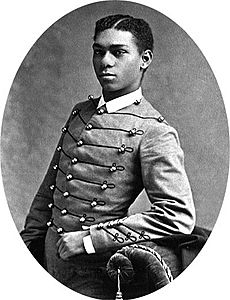
The years after the Civil War were challenging for the academy. It worked to welcome back students from the former Confederate states. The first students from Southern states returned in 1868.
In 1870, the first African-American cadet, James Webster Smith, was admitted. He did not graduate, but Henry O. Flipper became the first African-American graduate in 1877. Between the Civil War and 1900, 12 African-American cadets were admitted, with three graduating. This was quite progressive for the country at that time.
The curriculum also changed. It moved from being mostly about engineering to a broader education. The academy's control shifted from the Corps of Engineers to the Secretary of War. This meant that, for the first time, the Superintendents were not always engineers.
Other notable graduates from this period include George Washington Goethals (1880), who was the chief engineer of the Panama Canal, and John J. Pershing (1886), who led American forces in World War I. The Spanish–American War and the Philippine–American War caused the classes of 1899 and 1901 to graduate early to meet the demand for officers.
The Early 1900s and World War I
Around 1900, Congress increased the number of cadets to 481. This period saw a lot of new construction at West Point. Many old buildings were replaced with new ones, including barracks, academic buildings, and a gymnasium.
Many famous 20th-century generals graduated between 1900 and 1915. This group includes Douglas MacArthur (1903), George S. Patton (1909), Dwight D. Eisenhower, and Omar Bradley (both 1915). The Class of 1915 is especially famous, known as the "Class the Stars Fell Upon," because 59 out of 164 graduates became generals!
This time also saw the start of sports rivalries, like the famous Army-Navy football game, which began in 1890.
When America entered World War I, there was a huge need for army officers. West Point sped up the graduation of its students. Classes graduated early, with some completing their studies in just two years instead of four. This helped provide many new officers for the war effort.
Between the World Wars: Modernizing West Point
Between World War I and World War II, West Point worked to modernize its training for new warfare technologies. Douglas MacArthur, a decorated World War I soldier and a distinguished graduate, became Superintendent in 1919.
MacArthur made big changes to the academic program. He added more history and humanities courses. He also started the tradition of instructors studying at civilian universities before teaching at West Point. Under his leadership, the Cadet Honor Committee was formed in 1922, which helps cadets uphold honesty and integrity.
MacArthur strongly supported sports at the academy. He famously said, "Upon the fields of friendly strife are sown the seeds that, upon other fields, on other days, will bear the fruits of victory."
In 1925, West Point became an officially accredited institution. In 1933, it officially began granting a Bachelor of Science degree to all graduates. Before World War II, the academy also expanded its land to nearly 15,000 acres. In 1935, Congress increased the number of cadets to 1,960, leading to another building program.
World War II and Beyond
During World War II, Congress expanded the number of cadets to 2,496, and the academy switched to a three-year course of study. Many classes graduated early to meet the demand for officers. Nearly 500 graduates lost their lives in World War II.
After the war, Maxwell Taylor (class of 1922) became Superintendent in 1945. He brought in many changes that shaped the modern Military Academy. He added new professors and departments. He removed old courses like fencing and horsemanship and added new ones like nuclear physics and electronics. He also increased courses in leadership and psychology, helping graduates understand how to lead soldiers.
The Korean War did not disrupt the academy much. However, challenges with honesty among some cadets in 1951 led to fewer applications. West Point responded with its first modern advertising campaign. In 1955, the movie The Long Gray Line and the TV series The West Point Story helped boost interest in the academy.
In the 1960s, the number of cadets grew from 2,200 to 4,400. The curriculum became more advanced, and new academic departments were created.
Women at West Point: A New Era
West Point first welcomed women as cadets in 1976. This happened after Congress allowed women to join all federal service academies. Today, about 15% of new students are women. They go through the same academic and military training as men, with slightly different physical fitness standards. The first class with female cadets graduated in 1980.
Since then, several women have achieved important milestones. Kristen Baker became the first female first captain (the highest-ranking cadet) in 1989. As of May 2018, five women have held this top leadership position. In 1995, Rebecca Marier became the academy's first female valedictorian (the student with the highest grades). The first female West Point graduate to become a general was Rebecca S. Halstead, class of 1981. She was promoted to brigadier general in 2005.
In 1980, Vincent K. Brooks became the first African-American first captain.
In 1985, cadets were allowed to choose a major for the first time. Before this, all graduates received a Bachelor of Science degree without a specific major. Even today, because of the strong focus on math and science, all cadets receive a Bachelor of Science degree, no matter what they major in.
West Point was also an early adopter of the internet. In 1996, all cadets got free internet access in their rooms. Today, the academy is recognized for its high use of the internet in daily activities.
Academy Coat of Arms
The academy's coat of arms was designed in 1898. The shield is topped by the American bald eagle. It also features the academy's motto, "Duty, Honor, Country," and "West Point MDCCCII USMA," which shows the founding date of 1802.
The helmet on the coat of arms represents Pallas Athena, a symbol of wisdom and learning. The sword is a traditional symbol of the military.


